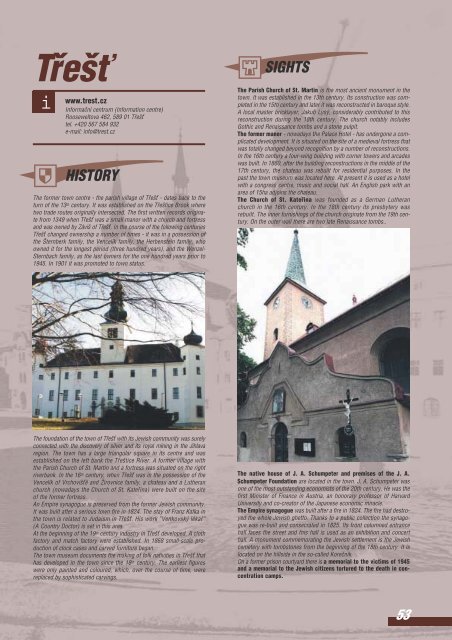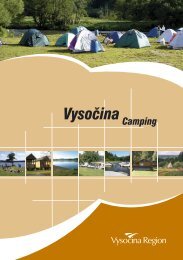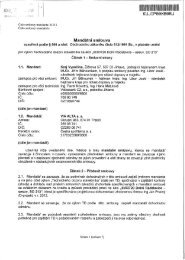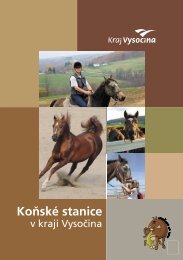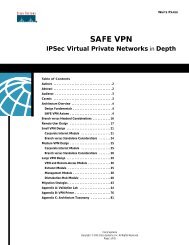history - Extranet
history - Extranet
history - Extranet
- No tags were found...
You also want an ePaper? Increase the reach of your titles
YUMPU automatically turns print PDFs into web optimized ePapers that Google loves.
Tfie‰Èiwww.trest.czInformaãní centrum (Information centre)Rooseweltova 462, 589 01 Tfie‰Ètel. +420 567 584 932e-mail: info@trest.czHISTORYThe former town centre - the parish village of Tfie‰È - dates back to theturn of the 13 th century. It was established on the Tfie‰tice Brook wheretwo trade routes originally intersected. The first written records originatefrom 1349 when Tfie‰È was a small manor with a church and fortressand was owned by Závi‰ of Tfie‰È. In the course of the following centuriesTfie‰È changed ownership a number of times - it was in a possession ofthe ·ternberk family, the Vencelík family, the Herbenstein family, whoowned it for the longest period (three hundred years), and the Wenzel-Sternbach family, as the last owners for the one hundred years prior to1945. In 1901 it was promoted to town status.SIGHTSThe Parish Church of St. Martin is the most ancient monument in thetown. It was established in the 13th century. Its construction was completedin the 15th century and later it was reconstructed in baroque style.A local master bricklayer, Jakub Lys˘, considerably contributed to thisreconstruction during the 18th century. The church notably includesGothic and Renaissance tombs and a stone pulpit.The former manor - nowadays the Palace Hotel - has undergone a complicateddevelopment. It is situated on the site of a medieval fortress thatwas totally changed beyond recognition by a number of reconstructions.In the 16th century a four-wing building with corner towers and arcadeswas built. In 1860, after the building reconstructions in the middle of the17th century, the chateau was rebuilt for residential purposes. In thepast the town museum was located here. At present it is used as a hotelwith a congress centre, music and social hall. An English park with anarea of 15ha adjoins the chateau.The Church of St. Katefiina was founded as a German Lutheranchurch in the 16th century. In the 18th century its presbytery wasrebuilt. The inner furnishings of the church originate from the 19th century.On the outer wall there are two late Renaissance tombs..The foundation of the town of Tfie‰È with its Jewish community was surelyconnected with the discovery of silver and its royal mining in the Jihlavaregion. The town has a large triangular square in its centre and wasestablished on the left bank the Tfie‰tice River. A former village withthe Parish Church of St. Martin and a fortress was situated on the rightriverbank. In the 16 th century, when Tfie‰È was in the possession of theVencelík of Vrchovi‰Èû and Îirovnice family, a chateau and a Lutheranchurch (nowadays the Church of St. Katefiina) were built on the siteof the former fortress.An Empire synagogue is preserved from the former Jewish community.It was built after a serious town fire in 1824. The stay of Franz Kafka inthe town is related to Judaism in Tfie‰È. His work ”Venkovsk˘ lékafi”(A Country Doctor) is set in this area.At the beginning of the 19 th century industry in Tfie‰È developed. A clothfactory and match factory were established. In 1868 small-scale productionof clock cases and carved furniture began.The town museum documents the making of folk nativities in Tfie‰È thathas developed in the town since the 18 th century. The earliest figureswere only painted and coloured, which, over the course of time, werereplaced by sophisticated carvings.The native house of J. A. Schumpeter and premises of the J. A.Schumpeter Foundation are located in the town. J. A. Schumpeter wasone of the most outstanding economists of the 20th century. He was thefirst Minister of Finance in Austria, an honorary professor of HarvardUniversity and co-creator of the Japanese economic miracle.The Empire synagogue was built after a fire in 1824. The fire had destroyedthe whole Jewish ghetto. Thanks to a public collection the synagoguewas re-built and consecrated in 1825. Its front columned entrancehall faces the street and this hall is used as an exhibition and concerthall. A monument commemorating the Jewish settlement is the Jewishcemetery with tombstones from the beginning of the 18th century. It islocated on the hillside in the so-called Koreãník.On a former prison courtyard there is a memorial to the victims of 1945and a memorial to the Jewish citizens tortured to the death in concentrationcamps.53


